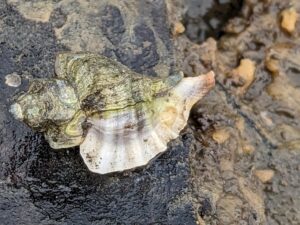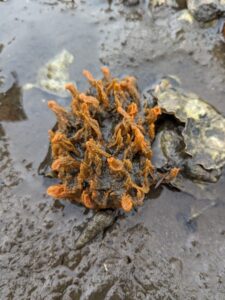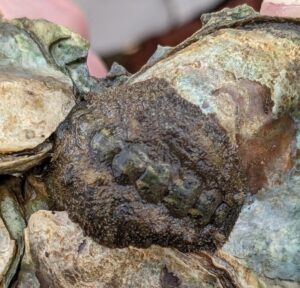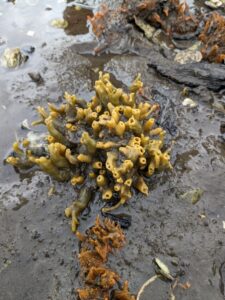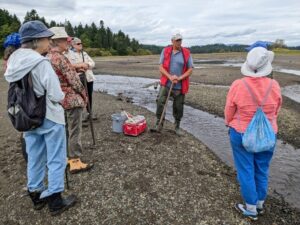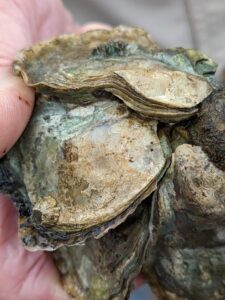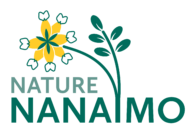By Staffan Lindgren | August 7, 2023
Nine Nature Nanaimo members led by Rick Harbo visited the tidal mudflats of “Oyster Bay”, just north
of Ladysmith, on August 2. The weather was perfect with overcast skies and a cool breeze. Rick led us
out onto the mudflats to show this unique area where the majority of organisms are introduced. It is
also one of the few remaining strongholds in the Salish Sea of our native oyster, the Olympia oyster. The
shallow bay is unusually warm for this area, allowing animals that normally could not survive around
Vancouver Island to thrive. Rick has an encyclopedic knowledge of both the identity of the animals, but
also of the history of the area. Rick grew up in Saltair between Ladysmith and Chemainus so he knows
this area intimately.
Ladysmith Harbour was initially named and charted as Oyster Bay (1859 because it used to have a large
population of our native Olympia oyster (aka Western, California or Rock oyster, Ostrea lurida). The
species was heavily harvested in the 1800’s until the 1930’s, causing population decline. Much of the
harvest was shipped to California. The Olympia oyster is now listed as a species of special concern in
Canada. There were attempts from 1896 to 1936 to grow Atlantic oysters Crassostrea virginica in
Ladysmith Harbour. The culture of Atlantic oysters failed, and today’s commercial oysters are introduced
from Japan, now called Pacific oysters, Magallana gigas. This is a large oyster is pretty much present
everywhere along rocky Salish Sea shores at this point. We also found some Japanese oyster drills,
Ocinebrellus inornatus, a predatory marine snail. It was introduced to the Pacific Northwest in the mid
1920’s. As the name implies, the snail drills a hole through the shell of oysters and other bivalve
molluscs with thin enough shell using its radula and secreted sulfuric acid (!). It then secretes enzymes
and consumes the mollusc over time.
The first exotic we encountered on our walk was the Japanese mud snail, Batillaria attramentaria, which
can occur at staggering densities. It effectively outcompetes the native California hornsnail, Cerithidea
californica. Next we found shells of the Varnish clam, Nuttallia obscurata, another native of Japan, Korea
and China, along with the Manila clam, Ruditapes philippinarum. The latter is edible and has been
intentionally introduced in many areas. The introduction to BC was supposedly accidental, however.
There was also evidence of horse clams, Tresus nuttallii, which lay buried in the mud and responsible for
squirts of water when you pass by. A question about geoducks (Panopea generosa) led to an interesting
discussion. I have always wondered how “geoduck” came to be pronounced gooeyduck. Rick explained
that the name stems from the collection of these clams at Nisqually in Puget Sound on the U.S. Exploring
Expedition (https://en.wikipedia.org/wiki/United_States_Exploring_Expedition). The Lutshootseed
(Puget Sound Salish language) name gʷidəq means “dig deep”, which is consistent with the shell of the
large molluscs buried with only the one meter or longer siphon reaching the surface of the substrate.
Looking out over the mudflats there was an orange sheen. This was caused by a mud-adapted sponge,
the Crumb-of-bread Sponge, Hymeniacidon perlevis, originally discovered in the bay by Rick
https://www.ladysmithchronicle.com/news/unidentified-sponge-may-be-the-latest-marine-species-
invading-ladysmith-harbour-902286. Scattered among the orange sponges was a yellow sponge,
Halichondria bowerbanki, and a pink sponge Haliclona sp. One interesting find was an introduced
chiton, which Rick told us is unidentified to date. We also found evidence of the Pacific lugworm,
Abarenicola pacifica, a large polychaete marine worm that lives in a u-shaped burrow. It is a deposit
feeder. Lugworms leave characteristic castings which can be seen on the surface at low tide. We also
found another polychaete worm, a small (probably) native scale worm, so called because of the scales or
elytra covering their body. Some species in this diverse taxonomic group form symbiotic relationships
with other marine organisms.
All in all, we had a very successful outing and extend a big thanks to Rick for sharing his expertise.
Submitted by Staffan Lindgren
